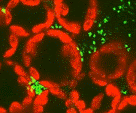Plant Pathology, Department of

Department of Plant Pathology: Faculty Publications
Document Type
Article
Date of this Version
4-24-2019
Citation
U.S. Government Work
Abstract
Wheat streak mosaic virus (WSMV; genus Tritimovirus; family Potyviridae) is an economically important wheat virus that is transmitted by the wheat curl mite (WCM; Aceria tosichella Keifer) in a persistent manner. Virus–vector coevolution may potentially influence vector gene expression to prolong viral association and thus increase virus transmission efficiency and spread. To understand the transcriptomic responses of WCM to WSMV, RNA sequencing was performed to assemble and analyse transcriptomes of WSMV viruliferous and aviruliferous mites. Among 7291 de novo-assembled unigenes, 1020 were differentially expressed between viruliferous and aviruliferous WCMs using edgeR at a false discovery rate 0.05. Differentially expressed unigenes were enriched for 108 gene ontology terms, with the majority of the unigenes showing downregulation in viruliferous mites in comparison to only a few unigenes that were upregulated. Protein family and metabolic pathway enrichment analyses revealed that most downregulated unigenes encoded enzymes and proteins linked to stress response, immunity and development. Mechanistically, these predicted changes in mite physiology induced by viral association could be suggestive of pathways needed for promoting virus–vector interactions. Overall, our data suggest that transcriptional changes in viruliferous mites facilitate prolonged viral association and alter WCM development to expedite population expansion, both of which could enhance viral transmission.


Comments
Gupta et al., Journal of General Virology 2019;100:889–910 DOI 10.1099/jgv.0.001256